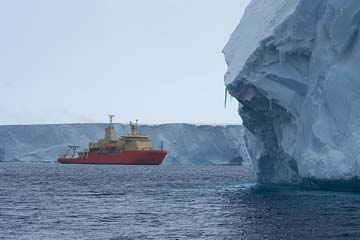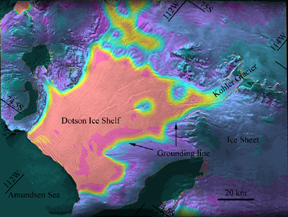Geotimes

Web
Extra
Wednesday, July 3
Grounding Antarctic
melting
The Antarctic ice sheet holds about 90 percent of Earth's frozen store of freshwater.
Its dynamics, particularly melting rates, have many implications for climate
change, from determining sea level rise to influencing ocean circulation patterns.
Now, scientists Eric Rignot from the Jet Propulsion Laboratory and Stanley Jacobs
from Lamont-Doherty Earth Observatory reveal in the June 14 issue of Science
that the bottoms of Antarctic ice shelves are melting much more rapidly at their
grounding lines than previously thought.
 National
Science Foundation research vessel Nathaniel B Palmer near the Mertz Glacier
Tongue in January, 2001. The Mertz is one of the 23 ocean extensions (shelves
and tongues) of the Antarctic ice sheet that Rignot and Jacobs show have rapidly
melting underbellies. Photo courtesy of Stan Jacobs.
National
Science Foundation research vessel Nathaniel B Palmer near the Mertz Glacier
Tongue in January, 2001. The Mertz is one of the 23 ocean extensions (shelves
and tongues) of the Antarctic ice sheet that Rignot and Jacobs show have rapidly
melting underbellies. Photo courtesy of Stan Jacobs.
"It's important because in the climate machine, which includes interactions
among ice, atmosphere and oceans, the component that has been overlooked is
ocean-ice interaction," says Terence Hughes, a glaciologist at the Institute
of Quaternary and Climate Studies in Maine. "Using satellite data, a means that
has revolutionarized the science, the authors better constrain an important
and extremely vulnerable part of the climate system, the ice sheets."
Ice shelves extend off the ice sheet and protrude into the ocean. Rignot and
Jacobs focus on the areas close to the grounding lines, where the ice detaches
from the seafloor and begins to float. Using satellite radar interferometry,
a technique that measures the change in size, velocity and shape of the ice
shelves, the scientists were able to precisely locate the grounding lines of
23 shelves.
Depths at which the different ice shelves detach from the seafloor vary. The
ocean water is 2 to 3 degrees above freezing and, due to its saline composition,
is able to melt the ice. At depth, increasing pressure causes greater melting.
Rignot and Jacobs note overall high basal melt rates, from less than 4 meters
per year for shallower grounding lines to greater than 40 meters per year at
deeper grounding lines.
 Image
of tidal motion of Dotson Ice Shelf, Antarctica, obtained from interferometric
synthetic-aperture radar data collected by the European Remote Sensing Satellite
ERS-1 in 1992. Grounded ice is colored blue, floating ice is colored red, the
transition from grounded to floating ice is colored blue, to light green, to
yellow and red as the ice adjusts to hydrostatic equilibrium. Bottom melting
is calculated in the proximity of that transition region. Image size is 100
km x 100 km. Image supplied by Eric Rignot.
Image
of tidal motion of Dotson Ice Shelf, Antarctica, obtained from interferometric
synthetic-aperture radar data collected by the European Remote Sensing Satellite
ERS-1 in 1992. Grounded ice is colored blue, floating ice is colored red, the
transition from grounded to floating ice is colored blue, to light green, to
yellow and red as the ice adjusts to hydrostatic equilibrium. Bottom melting
is calculated in the proximity of that transition region. Image size is 100
km x 100 km. Image supplied by Eric Rignot.
Although the authors suggest that presently the melt rates maintain
the equilibrium of the Antarctic ice sheet, they estimate that increased
ocean temperatures will lead to enhanced melt rates: a meter per year for
a 0.1 degree Celcius temperature increase.
"A change of 0.1 degree Celcius is not unrealistic, and a meter per
year thinning of ice is a large rate. In a hundred years an ice shelf can
disappear. Computer models suggest that an effective way to make an ice
sheet disappear is to melt its ice shelves," Rignot says.
Much of the seafloor around Antarctica actually deepens toward the shore
as the weight of thicker ice presses it down. Thus, additional bottom melting
would cause deeper grounding lines and this in turn would exacerbate the
melting process.
"This research does change the way we consider the Antarctic ice sheet.
We are getting at the underlying mechanism that causes ice sheets to melt
and we see that this melting is happening very quickly," Hughes says.
Salma Monani
(Modified July 9, 2002)
 National
Science Foundation research vessel Nathaniel B Palmer near the Mertz Glacier
Tongue in January, 2001. The Mertz is one of the 23 ocean extensions (shelves
and tongues) of the Antarctic ice sheet that Rignot and Jacobs show have rapidly
melting underbellies. Photo courtesy of Stan Jacobs.
National
Science Foundation research vessel Nathaniel B Palmer near the Mertz Glacier
Tongue in January, 2001. The Mertz is one of the 23 ocean extensions (shelves
and tongues) of the Antarctic ice sheet that Rignot and Jacobs show have rapidly
melting underbellies. Photo courtesy of Stan Jacobs.

 Image
of tidal motion of Dotson Ice Shelf, Antarctica, obtained from interferometric
synthetic-aperture radar data collected by the European Remote Sensing Satellite
ERS-1 in 1992. Grounded ice is colored blue, floating ice is colored red, the
transition from grounded to floating ice is colored blue, to light green, to
yellow and red as the ice adjusts to hydrostatic equilibrium. Bottom melting
is calculated in the proximity of that transition region. Image size is 100
km x 100 km. Image supplied by Eric Rignot.
Image
of tidal motion of Dotson Ice Shelf, Antarctica, obtained from interferometric
synthetic-aperture radar data collected by the European Remote Sensing Satellite
ERS-1 in 1992. Grounded ice is colored blue, floating ice is colored red, the
transition from grounded to floating ice is colored blue, to light green, to
yellow and red as the ice adjusts to hydrostatic equilibrium. Bottom melting
is calculated in the proximity of that transition region. Image size is 100
km x 100 km. Image supplied by Eric Rignot.